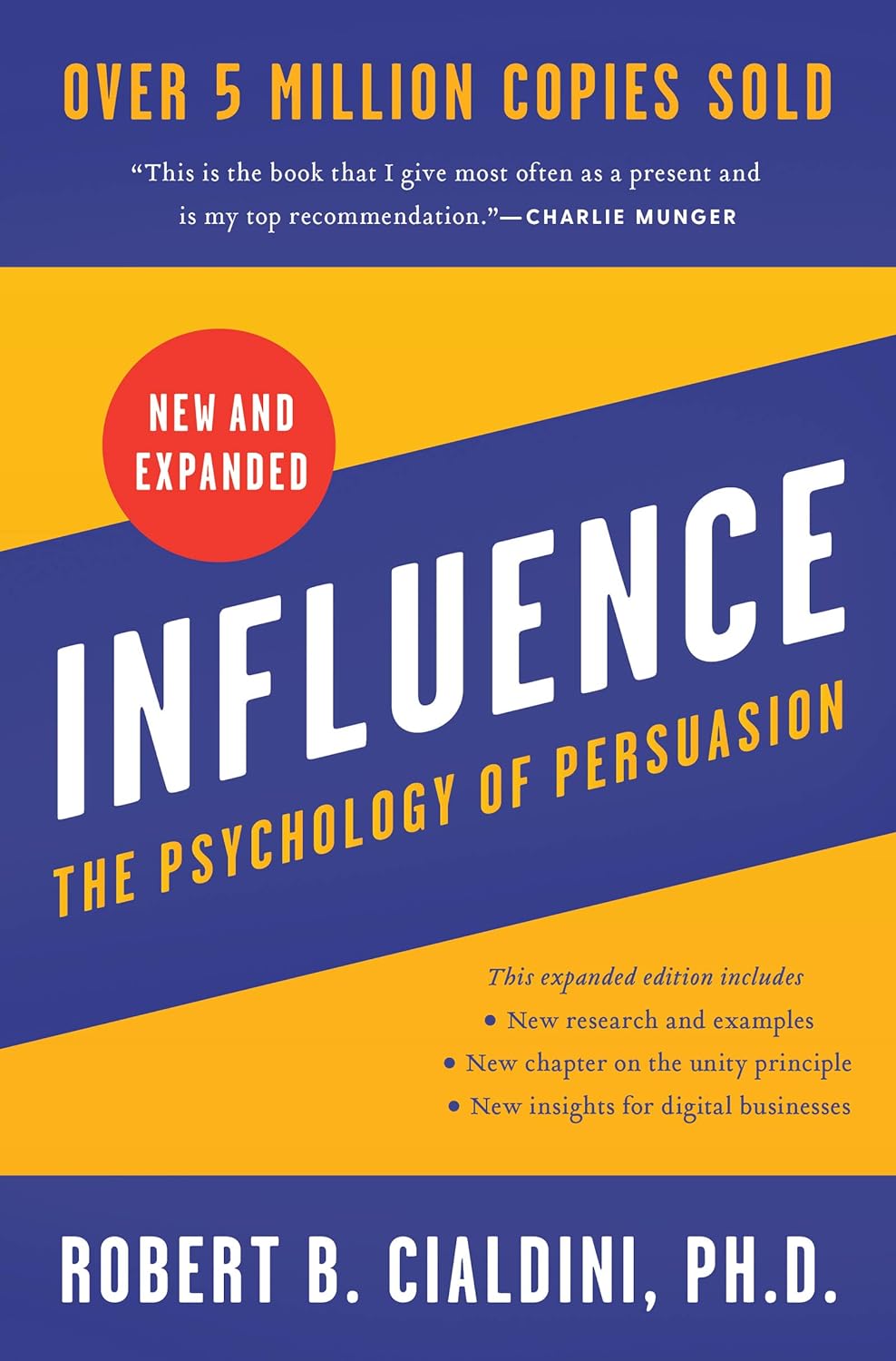How do you convince someone to listen to you? Offer you a job? Buy your product? To most people, including myself, getting better at even one of these things would greatly benefit not only my career but also my personal life. In Robert Cialdini’s book, Influence, time-tested (and academic research-tested) principles are outlined that can help you convince anyone of anything with six specific methods and strategies.
In this post, I’ll speed you through the most critical points, the headlines, so you can start using these principles ASAP. Also, importantly, I’ll outline what Dr. Cialdini outlines as the only possible ways to defend yourself against such tactics. Charlie Munger and Warren Buffet attribute much of their success to this book. Influence is Charlie Munger’s #1 business book of all time and Warren Buffet’s #3 business book of all time.
After reading this book, I implemented a couple of these strategies on my Beginner YouTuber Course and noticed a crazy bump in sales. Let’s get into it.
Reciprocation
There is no such thing as a free lunch.
Unknown
The reciprocity rule is that whenever we are given something for free, we feel indebted to provide something in return of at least equal value. Interestingly, we often give something back of higher value.
A straightforward example is a group of Krishna devotees that used the reciprocity rule to raise funds. Initially, the group had a failing strategy of simply asking for donations at airports or in malls. Later, they smartly shifted to the strategy of providing something free, such as a “gift,” first. A book, such as the Bhagavad Gita, or, the most well-known, a flower was given before asking for a donation. The flower was often pinned on your person without so much as a “what are you doing?” Also, the fundraisers were explicitly instructed never to take back their gifts. Then, and only then, was a donation asked for. And, with the expert manipulation of the human psyche, many people folded, “producing large-scale economic gains and funding the ownership of temples, businesses, houses, and property in 321 centers in the US and overseas.”
A sneakier method of using the reciprocation principle is the idea of “rejection-then-retreat,” wherein a more significant, almost ridiculous, request is made followed by a minor request. Imagine you want me to do something for you. Initially, you ask me for something huge, something ridiculous, and I, being a rational person, say no. However, next, you come at me with a minor request. I view this smaller request as you being nice to me. You are doing me a favor and lowering your ask to benefit me. I am much more likely to accept this new, more minor request because you have done me the favor of reducing your ask even though, sneakily, your minor request is what you wanted all along.
A fantastic example of this tactic is the Watergate scandal; I would google it quickly if you don’t know about it. The mastermind behind Watergate was G. Gordon Liddy, who had somehow convinced Nixon’s administration to undergo a $250,000 operation with ten men to burglarize and bug an opponent’s office. How could president Nixon’s administration approve something so ridiculous? Well, this wasn’t the first proposal by Mr. Liddy; in fact, it was the third. G. Gordon Liddy had perfectly used the “rejection-then-retreat” tactic. His initial proposal was a whopping $1,000,000 operation, including a kidnapping, mugging squad, and yacht. The only person who wasn’t sold on the final $250,000 plan was the only person present at the initial two proposals, a man named LaRue. The Nixon team thought this $250,000 plan, with no yacht or kidnapping, was reasonable, and they felt indebted to G. Gordon Liddy because he was seemingly reducing his ask to appease them; G. Gordon Liddy was using the “rejection-then-retreat” method.
So how do we use this? How can we take advantage of this strategy? I think there are a couple of key points:
- Give out free things and expect nothing in return… Until you ask for something in return later. The best examples are “free trials” or “free ebooks,” where the user is asked to subscribe or commit after receiving the trial or book. The most successful door-to-door salespeople often provide a free product initially, only to later ask for an actual purchase.
- Start with a dramatically large request, then retreat to the request you want. For example, when selling an item, initially sell the top-of-the-line model that very few people are likely to buy, then retreat to the middle model. Do not start at the bottom; begin at the top.
Finally, now that we understand what we are up against, we should be able to say “no,” right? Here is the best way to fight the reciprocity rule:
- The best way is to understand the person doing the favor for you. If the initial favor is actually a trick to get you to do something more significant in response at a later time, recognize it as that, and move on. Once the favor is identified as a tactic or trick, we can comfortably walk away.
- Another way to think about is: if you have identified the seller using this favor as an exploit for compliance, given the reciprocity rule and justice, exploitation attempts should be exploited. Recognizing the salesman has provided you with a free section of an encyclopedia to trick you into buying the whole set, thank him politely, take the book, and show him the door.
Commitment and Consistency
It is easier to resist at the beginning than at the end.
Leondardo Da Vinci
The trick of this strategy is to convince someone to commit to something, however small. Then, whether to appear consistent internally to themselves or the outside world, the person will continue along with you.
My favorite example in the book of commitment and consistency is that of American Prisoners of War in Chinese prison camps in the Korean War, where the Chinese were able to convince many Americans to inform on fellow Americans. Amazingly, “nearly all American prisoners in the Chinese camps are said to have collaborated with the enemy in one form or another.” How did the Chinese accomplish this? They started small, and they built.
Initial requests by the captors were for American Prisoners to write things such as, “The US is not perfect,” or, “In a Communist country, unemployment is not a problem.” Later, they may ask the captive to expand on this for a reward, such as asking for a list of reasons why the US isn’t perfect for more bread. Smartly, the Chinese would later broadcast everywhere this list. They would broadcast it everywhere, including the American’s home camp and the American’s prison cell with the American’s name. The American now felt they were known as a “collaborator,” because they have helped the enemy.
The prison camps even had essay contests describing the positives of the communist party where the winner received even more substantial awards such as fruit or cigarettes. Such small writings are not so harmless after all. POWs later came home with opinions that communism wasn’t such a bad thing in China.
Two important things I want to point out, American POWs were never forced to write anything, and when they did write, their writings were made broadly public. They are committing to this identity internally and externally. Internally, they have chosen to do the writings. Externally, their writings are now known not only to the Chinese but to their fellow Americans. If they identify as a “collaborator” and the rest of the world sees them as a “collaborator,” why would they do anything contrary to what a “collaborator” would do?
Some quick supporting experiments:
- A solicitor of cookies tried two techniques to sell cookies: first asking, “how are you doing?” and the other by asking, “do you want to buy cookies?” When the solicitor started with, “how are you doing,” compliance was 33% vs. the “do you want to buy cookies?” at 18%. Why? When the customer replied with, “good,” or “I am doing great thanks,” they have committed to being a “happy” person at that moment and will find it awkward to appear stingy after just admitting they are doing well.
- All fraternity and sorority pledging processes hinge on the ideas of commitment and consistency. A couple of pledgees have died during this process; their commitment has no bounds.
- Homeowners were told that if they pledged to conserve energy, their names would be publicly displayed in the newspaper. They saved more power than other families as measured by natural gas consumption. Amazingly, later, the researchers told the families that pledged that they actually couldn’t display their names. Guess what? They still conserved significantly more natural gas; they had identified themselves and a family that saves energy.
How can we take advantage of this lesson?
- Get them to say, “yes,” as soon as possible.
- The more permanent (etched in stone vs. verbal commitment) and public the commitment, the better.
- Never threaten, coerce, or bribe; it should be their choice.
How to say “no.”
- The author argues the best way to fight this is before you are asked to decide with someone or on some product, imagine that you are making that decision before you knew anything about that person or product. “Knowing what I now know, would I make the same choice if I could go back in time before I met this person or made my initial commitments?”
Social Proof
Why would someone put their own money in their tip jar? Canned laughter? Testimonials? These things exist because they work, get people to tip more, watch the TV show longer, buy the product. These things are social proof.
Social proof is the idea that it is usually the right option if everyone else is doing it. Evolutionarily this makes sense, “why is everyone running? You know, I’ll wait and consider thi”–SPLAT
One well-known example to me, and anyone who has gone through CPR training, is the bystander effect. You can lose points and fail the exam if you don’t point to someone and say, “You! Call 911!” or “You! Go get a defibrillator ASAP!” Why is this? Because it seems the more people around during an emergency, especially an uncertain emergency, the less likely aid will be provided. Everyone is sitting around doing nothing, so why should I do something? “Someone else will do it.” In one experiment, a student acted like he was experiencing a seizure around a specific number of people. When there was only one bystander present, the student received aid 85% of the time; when there were five bystanders present, the student only received help 31% of the time.
Social proof can have substantial, even deadly, consequences. Now, of course, remember correlation does not equal causation, but this is some strong correlation. For example, immediately following certain kinds of highly publicized suicide stories, the number of people who die in commercial-airline crashes increases by 1,000%, and automobile fatalities also dramatically increase. The author argues that this could be the Werther effect, where troubled people who read of another person’s self-inflicted death kill themself in imitation. This is one of the reasons that the Netflix series, 13-Reasons Why, received so much controversy and was eventually taken off of Netflix. The association of when the show was released and teen suicides was so high that many scientific journals cautioned parents not to let their teenagers watch the show.
Ok, let’s get non-morbid, how can we used the ideas of Social Proof to do better?
- What are you trying to sell? Can you show other people using the product or service? Can you find people who can give you a testimonial?
- Want someone to join your cause? Show them other people that are already with you.
- Want your son or daughter to start doing something? Show them their peers that are doing it.
How can we say “no” when someone tries to use the ideas of social proof against us?
- Identify when the social proof is being used and eject—ever seen those car commercials where the “average joe” is amazed at the car’s capabilities? It is not random; it is not luck, “average Joe” is actually “trained Tim” to make you buy.
- Take a step back from the autopilot and reason it out; this is much easier said than done, “why is everyone doing this? Is there a reason? Do I agree with that reason?”
Liking
The main work of a trial attorney is to make a jury like his client.
Clarence Darrow
People are more likely to say “yes” to someone they know and like than someone they don’t like.
The “halo” effect states that we automatically assign various good traits to someone based on one known good trait. For example, more attractive people are more frequently labeled as being more talented, kind, honest, and intelligent. More attractive political candidates receive more votes, more attractive defendants are more likely to avoid jail time.
We are also more likely to comply with people who have complimented us, we see more, or are more similar to us.
In one interesting experiment, a person and their friend were shown two images and asked to pick which image they like more. One image is the picture of the person, and the other picture is the person flipped, a mirror image of the person with their face flipped from right to left. Guess which photo was picked more? The person picked the flipped image of themself, and the friend decided on the regular image. Why? The individual who’s photo it is sees the flipped image every time they look in the mirror, while the friend sees the standard image. Isn’t that interesting? We are more likely to like the image we are exposed to more often without knowing it.
Finally, teams have a magical ability to bring together people who initially disliked each other. This is why good cop / bad cop works more frequently than not. The prisoner feels that the “good cop” is on their team against the “bad cop.”
Taking advantage of “liking.”
- Befriend the client before you ask for anything.
- Maximize your physical attributes as much as possible, whether this is getting a nice haircut, neater clothes, or brushing your teeth more often.
- We are more likely to help those that are similar to us. One way to take advantage of this is dressing like those you are trying to sell to and selling to lawyers? Dress like a lawyer. Selling to college students? Dress like a college student.
- Am I trying to win someone’s favor? Seriously, show your face more. Be around them more. I don’t have a unique icon or logo as my profile picture on YouTube or Twitter. I have my face.
How to say “no.”
- Separate the person from the product. “It’s nothing personal, just business.” Recognize your feeling of like for the person; it’s ok to have that feeling but don’t let that feeling cloud your senses of what you are trying to purchase or do.
Authority
Suppose you participate in an experiment where you are helping another person memorize words. You meet the lead scientist in their fancy white coat and fancy glasses, and they outline the investigation for you. Your partner is assigned a list of words to remember, and every time they mess up, you deliver an increasingly high voltage of shock to them. Initially, they respond with a slight grunt at the 75, 90, 105-volt levels. Then, however, the voltage gets higher. At the 150 volt level, your partner screams, “That’s all! Get me out! I quit!” The fancy lead scientist tells you, “keep going; it’s for your partner’s benefit.” And, so, you keep shocking, 200 volts, 300 volts. You are not unlike the rest of the people in the experiment around you; 65% of the participants carried out the instructions faithfully, giving the maximum shock, even when someone said, “That’s all. Get me out of here! I told you I had heart trouble. My heart’s starting to bother me! I refuse to go on. Let me out!”
Now, this is, of course, Stanley Milgrams’s famous shock experiment. The partner receiving the shock was an actor, and no real shock was given. Why did 65% of people deliver the maximum voltage? They weren’t psychopaths; they were regular people like you and me. Milgram argues, “it is the extreme willingness of adults to go to almost any lengths on the command of an authority.”
Why are people perceived to be in authority? One reason may be their title. In one interesting study, a man was introduced as a visitor from Cambridge to a group of Australian college students but was given a different title in different classes. In one class, he was a student, another class a demonstrator, another class a lecturer, another class a senior lecturer, and finally, a professor. Amazingly, he was perceived to be on average 0.5″ taller at each higher title.
How can we take advantage of this?
- Try and display yourself as an authority while, of course, being ethical in regard to your title. I, for example, do not display myself as an “MD” yet because I am not one. However, I mention that I am in medical school when I talk about studying because there is some authority based on the academics to be accepted into medical school. Use what you have.
- Dress professionally if you want to appear professional. Uniforms are even more powerful.
How to say “no.”
- What is the evidence for their authority status, especially what they are talking about? Physicians, lawyers, judges, legislative leaders usually have their positions from extensive training. I would trust medical advice from my doctor. However, I would not take investment advice from my doctor. I know he has not had extensive training in that subject.
- Ask yourself, “how can the expert benefit from my compliance?” What is the incentive (as a side note, this is a hugely important question to ask at all times)? I urge you to experiment with asking a waiter to decide between two items for you, one being very expensive and one being not so expensive. See which item the waiter more often chooses.
Scarcity
The way to love anything is to realize that it might be lost.
G. K. Chesterton
The idea of scarcity is that humans are more motivated by the thought of losing something than the thought of gaining something of equal value. A penny lost is much scarier than a penny gained.
In one experiment out of Virginia, two-year-old boys were put in a room with two toys. One toy was behind a barrier in the room, while the other was adjacent behind no barrier. The barriers were varied in size. One barrier was only one foot high, easily traversable by the 24-month olds. However, for other boys, the barrier was two feet high, making access to the toy virtually impossible unless they went around the barrier. The findings were clear; when the barrier was small, the boys had no preference for either toy. However, when the barrier was high, initially blocking the boy’s access to one of the toys, the boys strongly preferred the toy behind the barrier. The boy’s preferred the toy that was harder to get to.
In another experiment, a company that sold beef to supermarkets phoned the supermarkets in one of three ways: a standard sales pitch, a sales pitch plus information that the supply of beef would likely be scarce in the next month, and, finally, a sales pitch plus information that the supply of beef would likely be scarce plus the information that the news that the supply would be scarce was not generally available information. Guess which phone call performed best?
Scarcity is one of the most powerful ways to influnce someone.
- Add a deadline or limited stock
- To increase demand, even more, apply information scarcity
How to say “no.”
- The joy comes in possessing a scarce commodity as opposed to experiencing it. This is a vital but challenging difference to understand. Think about why you want the item or thing; studies show that the experience of the “scarce” product is no better than if it is not a “scarce” product. So, carefully examine why you want the product. A fancy car that there are only 10 of does we wish because it drives better or feels better than any other car in the world? Or because there are only 10 of them? A helpful rule is to wait for 24-hours before making the purchase.
Summary
That’s it! I really liked this book because Dr. Cialdini uses anecdotes and scientific experiments to illustrate his points. Here are the major take-aways from this book
- Reciprocity: provide something for free initially before asking for anything. Start with a large request, more significant than you want, before coming to a smaller ask of what you want.
- Commitment and Consistency: in order to persuade someone, have them decide to commit as publically and permanently as possible.
- Social Proof: Show that other people, whether actually or as actors, support and love your cause. Who are your audience’s peers?
- Liking: Befriend first, maximize physical attributes, have a consistent appearance, and appear consistently.
- Authority: Use titles and professional attire. Why should we listen to you?
- Scarcity: Add a deadline, limited stock, and scarcity of information.





2 comments
Arlo
Love this Zack!
Zach
Thanks for the read!